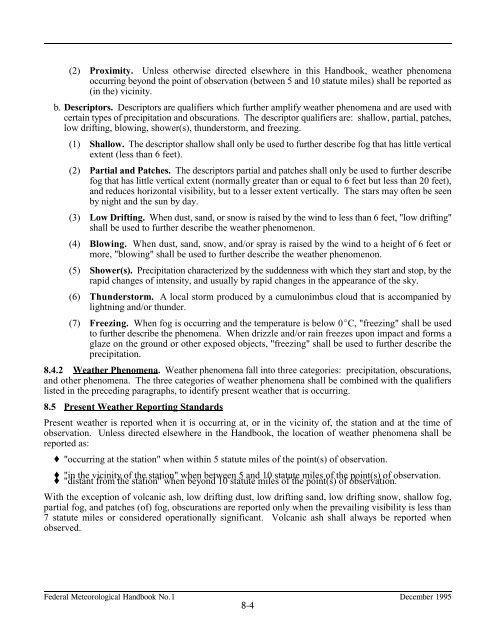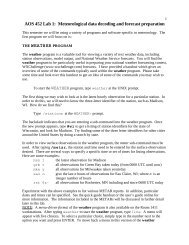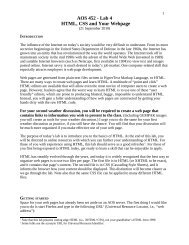Federal Meteorological Handbook No. 1 - Marrella
Federal Meteorological Handbook No. 1 - Marrella
Federal Meteorological Handbook No. 1 - Marrella
You also want an ePaper? Increase the reach of your titles
YUMPU automatically turns print PDFs into web optimized ePapers that Google loves.
(2) Proximity. Unless otherwise directed elsewhere in this <strong>Handbook</strong>, weather phenomena<br />
occurring beyond the point of observation (between 5 and 10 statute miles) shall be reported as<br />
(in the) vicinity.<br />
b. Descriptors. Descriptors are qualifiers which further amplify weather phenomena and are used with<br />
certain types of precipitation and obscurations. The descriptor qualifiers are: shallow, partial, patches,<br />
low drifting, blowing, shower(s), thunderstorm, and freezing.<br />
(1) Shallow. The descriptor shallow shall only be used to further describe fog that has little vertical<br />
extent (less than 6 feet).<br />
(2) Partial and Patches. The descriptors partial and patches shall only be used to further describe<br />
fog that has little vertical extent (normally greater than or equal to 6 feet but less than 20 feet),<br />
and reduces horizontal visibility, but to a lesser extent vertically. The stars may often be seen<br />
by night and the sun by day.<br />
(3) Low Drifting. When dust, sand, or snow is raised by the wind to less than 6 feet, "low drifting"<br />
shall be used to further describe the weather phenomenon.<br />
(4) Blowing. When dust, sand, snow, and/or spray is raised by the wind to a height of 6 feet or<br />
more, "blowing" shall be used to further describe the weather phenomenon.<br />
(5) Shower(s). Precipitation characterized by the suddenness with which they start and stop, by the<br />
rapid changes of intensity, and usually by rapid changes in the appearance of the sky.<br />
(6) Thunderstorm. A local storm produced by a cumulonimbus cloud that is accompanied by<br />
lightning and/or thunder.<br />
(7) Freezing. When fog is occurring and the temperature is below 0�C, "freezing" shall be used<br />
to further describe the phenomena. When drizzle and/or rain freezes upon impact and forms a<br />
glaze on the ground or other exposed objects, "freezing" shall be used to further describe the<br />
precipitation.<br />
8.4.2 Weather Phenomena. Weather phenomena fall into three categories: precipitation, obscurations,<br />
and other phenomena. The three categories of weather phenomena shall be combined with the qualifiers<br />
listed in the preceding paragraphs, to identify present weather that is occurring.<br />
8.5 Present Weather Reporting Standards<br />
Present weather is reported when it is occurring at, or in the vicinity of, the station and at the time of<br />
observation. Unless directed elsewhere in the <strong>Handbook</strong>, the location of weather phenomena shall be<br />
reported as:<br />
� "occurring at the station" when within 5 statute miles of the point(s) of observation.<br />
� "in the vicinity of the station" when between 5 and 10 statute miles of the point(s) of observation.<br />
� "distant from the station" when beyond 10 statute miles of the point(s) of observation.<br />
With the exception of volcanic ash, low drifting dust, low drifting sand, low drifting snow, shallow fog,<br />
partial fog, and patches (of) fog, obscurations are reported only when the prevailing visibility is less than<br />
7 statute miles or considered operationally significant. Volcanic ash shall always be reported when<br />
observed.<br />
������������������������������������ �������������<br />
���





